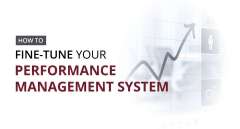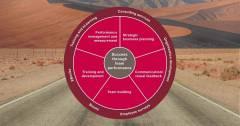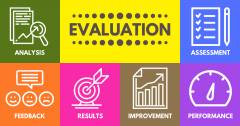What gets measured gets done.
Every person in an organization is employed to deliver results (outputs) that contribute to the organization as a whole. Effectiveness is judged by the extent to which internal and external customer demands for outputs are met.
In the long run, everyone is measured against whether the customers' demands and his or her many and varied expectations for outputs have been satisfied. The concept of the customer is broadened to include all the stakeholders of a given organization or team. Organizational performance is judged by the extent to which stakeholder demands for outputs are met.
Performance measures are integral to the building of systems that will lead to the continuous improvement of team performance. Specifically, it is essential to identify all the relevant stakeholders, determine a balanced set of outputs, measures (KPIs) and targets, and implement performance feedback, in order to implement the many initiatives that organizations are engaged in to improve their performance.
1. STRATEGIC PLANNING SYSTEMS
Many companies have strategic plans but they often do not work well because they are not implemented. As Fortune discovered, Less than 10% of strategies effectively formulated are effectively executed.
The workforces of many companies go about their daily business totally unaware of the fact that their companies have strategic plans. As a result, there is no relationship between company plans and the workers' activities.
The key to success lies in translating the vision and the strategic business plans into the everyday activities of the people who are actually doing the work, adding the value, providing the service, so that everybody knows exactly what to do on Monday morning in order to achieve results.
The building industry, for example, has mechanisms in place designed to move a project from an architect's vision of a four-bedroom house to the creation of that house exactly as planned. Everyone involved in the project knows how their contribution fits into the big picture.
Unfortunately, many businesses are lacking a mechanism or system to translate their abstract visions and plans into measurable outputs so that every person in the organization knows exactly what outputs they are expected to produce, and how those outputs are to be measured. Performance measures will help you disseminate your goals amongst your workers, translating your strategic plan into their everyday activities. In other words, they will provide you with a process to implement the strategy. The objective is to implement a performance system that is hierarchically and mathematically connected to the organization's vision and that will focus all levels of the organization on achieving its vision.
See our publication: A common-sense approach to business planning
2. PERFORMANCE MANAGEMENT SYSTEM
Most performance management systems fail because they do not make the crucial link between strategy and daily actions and operations. They focus attention on tactical feedback and control of short-term operations.
A good performance management system provides a comprehensive framework that translates an organization's vision and strategy into a coherent set of outputs, performance measures and targets.
By developing a set of outputs, measures, targets and feedback systems for the leadership team, and then cascading these down the organization in such a way that they are localized, meaningful, understood, owned and aligned, the link between the organization's strategic goals and the daily actions of the people doing the work can be made.
Resource allocations, annual budgets, and strategic decisions can be driven by the strategy. Performance reviews can be used to monitor individual performance which in turn monitors organizational performance. Reward systems can be designed to reward organizational performance achievement. The vital link between what people are doing on a daily basis and strategic goals can be made.
A good performance management system must mobilize the people in the organization in such a way that their daily activities bring them closer and closer to strategic goal achievement. The performance management system must be a systematic process to implement the strategy.
3. TEAM PERFORMANCE SYSTEMS
If one person, acting alone, cannot deliver the product or service, a team must be formed to get the job(s) done. That is the basis of every organization and the reason that all organizations depend upon teamwork. Teamwork can occur in varying degrees and, because we are dealing with human beings, the potential to improve the teamwork is limitless.
The philosophy of the team is well summed up in the motto One Team, One Direction. The importance of teamwork is illustrated by the fact that a champion team will always beat a team of champions, thanks to the synergies inherent in teamwork.
More and more companies are belatedly recognizing the competitive advantages to be gained from playing as a team - especially one that includes the people in the front-line, adding value. More and more books and articles on teamwork are appearing. Yet many questions and doubts slow the implementation of the team concept. For a complete discussion of teamwork, see Sacher Associates, Success through team performance.
Meanwhile, many of the issues raised by the questions about teamwork can be resolved by identifying customers, formulating teams, allocating team outputs, and devising measurements, targets, and feedback systems. Of all the structures that support sophisticated teamwork, none is more important than a hierarchical measurement system that works.
4. TOTAL QUALITY MANAGEMENT
Some companies put the need for short-term profit and increased production above the need for customer service and quality.
The Quality movement, under the banner of Total Quality Management (TQM), led by people such as Deming, Juran, and Crosby, and aided by the spectacular way in which the Japanese have applied their principles, has taught us to think differently.
Total Quality Management is an overall philosophy based on the premise that customer satisfaction, improved market share and profit growth result from the highest quality standards in all internal and external processes, from the utilization of all resources and from a commitment to continuous improvement. TQM has been described by the Quality and Productivity Management Association of the United States as a customer-focused strategic and systematic approach to continuous performance improvement. The fundamental lesson of the Quality movement is that customers should be treated as well as are the stockholders. Allowing the desires of internal and external customers to "drive" all aspects of quality and the processing system will result in increased production and profit.
So where do measures fit in?
Summing up his advice to managers in a single sentence, Mr. Deming said that they should control variance. In other words, outputs or results must be delivered exactly according to internal or external customer requirements, with no variation (or to put it another way, zero defects).
A system for measuring and feeding back variation in outputs from the point of view of the customer is, therefore, an essential first step in controlling variance and implementing a philosophy of Total Quality Management.
5. BENCHMARKING
Benchmarking is a process of comparing your company's products, services, and processes to those of the acknowledged leaders, so as to compete with the best.
Many companies set out on the benchmarking journey find themselves defeated before they begin because they do not have an objective mechanism for measuring their products or services from the point of view of their customers. A company cannot benchmark unless it can measure itself.
An ongoing, systematic and two-way benchmarking program can also help determine what the outputs should be, which measures work well, and at what level the targets should be set.
6. REWARD SYSTEMS
Rewarding performance in a financial way is contingent upon good measurement systems. The greater the potential reward, the greater the degree to which the measurement system will be tested.
The potential rewards at the highest levels of tennis are enormous - and the measurement system determines who will receive what with minimum controversy. In boxing, on the other hand, there is a greater degree of subjectivity in the way performance is measured, resulting in a greater degree of controversy.
Many reward systems fail because the measurement systems are not rigorous enough to withstand the pressures created by people unhappy with the way the corporate cake was divided. Even more serious is the absence of measures to determine the size and dimensions of the cake before future arrangements are negotiated.
A clear system for measuring the creation, dimensions, and value of results produced is an absolutely essential prerequisite for a reward system that motivates everybody, especially the large majority of workers at the level where the value is created.
7. EMPOWERMENT
Alignment is the necessary condition before empowering the individual will empower the whole team . Peter Senge
Empowerment is the creation of an organizational culture in which all employees use as much of their ability as possible, in a unified and synergistic way, so as to produce the results required by internal and external customers and stakeholders.
In order to clarify the notion of empowerment, we need to draw a distinction between what has to be done and how it is to be achieved.
What has to be done is determined in consultation with the stakeholders and customers, who may be internal or external. This is done by clarifying exactly what outputs are required, how those outputs are to be measured, and what targets or standards are acceptable.
How best to achieve these outputs should be left to the experts, whom we define as 'the people doing the job'. As the old saying suggests, If you want to know the road up a mountain, ask the man who walks it every day.
If outputs, measures, and targets are clarified at all levels of the organization, if each individual and the team to which she/he belongs knows exactly what is expected, then, and only then, is everyone empowered.
Empowerment exists because the targets and standards form parameters within which people can exercise authority, make decisions, solve problems, communicate, utilize resources and generally implement solutions.
This is exactly the way organizations are run at the upper management levels. Similar systems, including systems of measurement, should be created with the same degree of empowerment for workers and workforce teams, for those who are in the front lines dealing with customers, for those who are adding value in the manufacturing plant. Doing so will create an environment in which the energy released from unlocking human potential can be harnessed and focused. The result will be increased productivity and quality of working life.
8. BUSINESS PROCESS RE-ENGINEERING
Business process re-engineering is the implementation of strategies to re-examine and redesign, from the customer perspective, the systems and processes that make up an organization.
According to process re-engineering practitioners, Total Quality Management concerns itself with how well things are done, improving process flows and reducing variance. Process re-engineering, on the other hand, concerns itself with what is to be done. Process re-engineering addresses fundamental questions such as: Why does the organization exist? Can we reduce costs by 50 percent while maintaining customer service levels?
Currently, business process re-engineering is probably based on the fundamental shift toward reorganizing the business to provide value to customers. The process begins with a question: Given a blank piece of paper and all the developments in technology, information systems, increased understanding of quality principles, human resources and the importance of the customer, how would we change our business today to best satisfy customer needs?
For those involved in the business of process re-engineering, the starting point has to be the development of clear outputs and measurement systems against which the process re-engineering options can be evaluated.
9. CONTRACTING-OUT SERVICES
In the face of tough economic times and increasing worldwide competition, there is increasing pressure on organizations to improve the quality and cost-effectiveness of their outputs and services.
Many private sector businesses and large parts of the public sector are in the process of contracting out non-core activities while retaining overall responsibility for the delivery of outputs and services to their customers.
Clarifying customers, and identifying outputs, measures, targets, and information systems, is indispensable if the goals behind contracting-out services (continuously improving quality and cost-effectiveness of outputs and services to customers) are to be achieved.
10. STRATEGIC ALLIANCES
Strategic alliances are aimed at replacing historically adversarial relations between, for example, a firm and its suppliers, or a firm and its customers, with a more committed cooperative relationship. This would contribute to a sustainable competitive advantage and the achievement of major goals for both parties.
The formulation of strategic alliances differs from contracting-out services in the same way dating differs from a marriage. It has to do with a long-term commitment and the replacement of adversarial negotiations with more of a win/win approach.
In common with any long-term relationship, clarifying upfront the outputs to be achieved, how those outputs are to be measured and what standards are acceptable will enhance the chances of success and the degree to which the strategic alliance succeeds.
11. LEARNING ORGANISATIONS
A learning organization is one in which purposeful systematic and ongoing learning is an integral part of a continuous improvement system and a major contributor to sustainable competitive advantage.
All organizations utilize inputs such as money, material, machinery, information, and of course, people to achieve their outputs. All of those inputs, with the exception of people, are equally available to all competitors in a single market. What differentiates the more successful organizations is the quality of the people. It is the people and how they work together to process inputs into value-added outputs or services that are the key to sustained success.
In the absence of major technological, financial or organizational restructuring, the most direct route to continuous improvement is for teams within organizations to continuously learn together.
The ability to learn faster than competitors may be the only sustainable advantage. Arie De Geus
An organization's capacity to learn needs to expand, at an ever-increasing rate just to keep up with technology, information, and global competition.
The goal of organizational learning, however, is not just learning but performance. See our publication Performance linked learning.
If organizations were to define specifically the outputs required by internal or external customers, how those outputs were to be measured, and what standards or targets are acceptable, then exact training requirements could be defined in performance terms. Training programs, which are generally very expensive, could then be finely focused on identified outputs and performance requirements. This common ground between trainers and managers could form the bedrock on which the learning organization is established.
TALK TO US ABOUT HOW WE CAN HELP YOUR BUSINESS
Book an obligation free clarity call to discuss our programs and your requirements.
Online Access, on our Learning Management System, or yours, to all five Sacher Associates courses:
- A Commonsense Approach to Business Planning
- Performance Measures Applied
- Performance Linked Communication
- Success Through Team Performance
- Performance Linked Learning
Discover how we can help your business increase productivity and improve performance:
- Discussion on consulting requirements
- Diagnostic review of your company
- Multiple User Access
- Access to Sacher Associates exclusive closed Facebook Group
- Customised courses and delivery solutions








